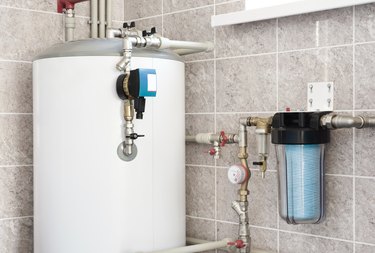
Hot water heating systems aren't exactly a new thing, but the ones you find in modern homes with baseboard heaters and heated floors aren't the same as those in older homes and office buildings with cast iron radiators. Both systems rely on a boiler to heat water, but in older gravity-fed systems, heated water or steam circulates by convection, while contemporary hydronic systems utilize a circulation pump. The pump provides more even heating and allows the boiler to be placed at the same level or even above the heating elements.
Hydronic heating systems are quiet and clean, and they are more energy-efficient and have fewer moving parts than other systems. A key benefit for people living in cold climates that require windows to stay closed in the winter is that hydronic heat doesn't dry out the air the way forced air systems do. Moreover, hydronic heat can be split into zones so different parts of a house can be maintained at different temperatures.
Video of the Day
Video of the Day
The Boiler Is the Heart of the System
A boiler is akin to a water heater, but it is part of a closed system in which water is recirculated, and additional cold water needs to be introduced only occasionally, not continuously. The boilers that generated steam for early gravity-fed heating systems were quite large and had pressure valves and gauges that made them look like something you would find in a submarine. Contemporary boilers are much more compact — sometimes no larger than a tankless water heater — and much simpler.
A boiler generates heat by burning natural gas or propane, and the combustion chamber, like that of a gas furnace, may not be fully sealed. However, just as there are high-efficiency furnaces with sealed combustion chambers and secondary heat exchangers to extract extra heat from combustion gases, there are high-efficiency boilers capable of converting 98 percent of the heating potential in fuel into actual heat.
Hot Water Circulation Produces Radiant Heat
In a simple, single-zone system, pipes lead out from the boiler to the heating elements in the building, which are usually baseboard heaters or radiant wall heaters (which are sometimes manufactured to look like the cast-iron radiators of old gravity-feed systems). Hot water can also circulate through pipes embedded in a concrete subfloor or installed through the joists of wooden floors. A circulation pump situated near the boiler outlet keeps the hot water moving, and it radiates heat through the heating elements before returning in a closed loop back to the boiler. Water expands when it heats up, so the boiler has an expansion tank to relieve pressure.
In a multizone system, water travels from the boiler to a manifold, which is a system of valves that split the main path into branches to serve different areas of the house. The valves have electronic controls that can be set to limit flow through each branch, thereby controlling temperature in that part of the house.
Alternatives to Traditional Boilers
Radiant heating systems using heating boilers have long been employed in North America, and they are even more common in Europe and other parts of the world. A common innovation in Europe is the combi-boiler, which supplies hot water for the household as well as for heating. These units fire up instantaneously when someone calls for hot water, and when there is no hot water demand, they monitor the heating system using a separate set of controls and switch on when extra heat is needed.
High-temperature heat pumps provide another alternative to boilers for radiant heating systems. A heat pump uses electricity very economically because it works like an air conditioner in reverse. It's even possible to install a reversible heat pump that will blow cold air through air ducts in the summer and supply heat to the heating system in winter.